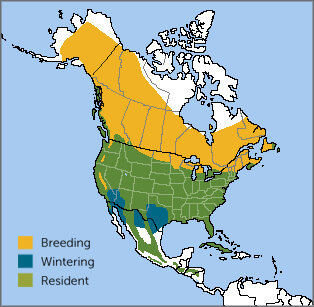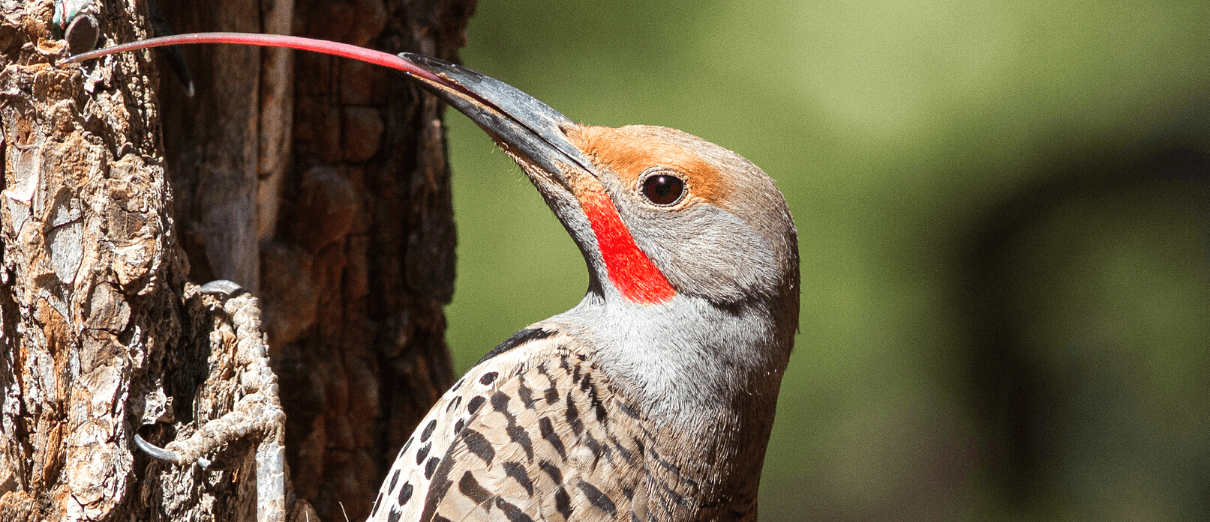
Northern Flicker range map by American Bird Conservancy
The Northern Flicker is a standout, even in an unusual family of birds that includes the pink-and-green, flycatching Lewis's Woodpecker and the clown-faced, nut-hoarding Acorn Woodpecker. This brownish-gray woodpecker, larger than an American Robin, has a black-barred back and is spangled below with black polka-dots. Easily recognized as it springs into flight, the flicker flashes a large white rump patch and bright red- or gold-colored wing linings.
The Northern Flicker is as noisy as it is flashy, so it's no surprise that over the years, it earned a host of folk names, including yellowhammer, harry-wicket, wick-up, and yarrup.
Tale of a Tongue
The tongues of most woodpeckers are adapted to spear and extract insects from wood, but the flicker's tongue is a bit different — in ways advantageous for lapping up large numbers of ants.
All woodpeckers have an elongated tongue attached to an arrangement of bones, cartilage, and muscles known as the hyoid apparatus, which wraps around the bird's skull, ending near the rear of its eye sockets. The Northern Flicker has an extra-long tongue that can extend up to two inches past the tip of its beak. It's the perfect tool for probing into anthills. This lengthy tongue is supported by an elongated hyoid bone, which extends into the bird's upper mandible.
The Northern Flicker also has large salivary glands that produce sticky saliva. Each time the bird extends its tongue, it gets re-coated with the sticky stuff — a veritable moving ant trap.
Ground-feeding Woodpecker
Unlike other woodpeckers, the Northern Flicker is commonly seen on the ground. There, it uses its long, slightly curved bill to probe into the soil, anthills, and rotting wood for ants, grubs, and other invertebrates. Ants make up much of its diet during the nesting season: One flicker's stomach was found to contain more than 5,000 ants!
This woodpecker also dines on other insects and their larvae, as well as fruit, especially wild cherries, wild grapes, and dogwood, sumac, and poison ivy berries. During the winter, more than half of its diet is comprised of wild fruits and nuts. Like the Red-bellied and Downy Woodpeckers, this bird will visit larger-sized suet feeders in the winter.
Along with the Common Grackle and many other bird species, the Northern Flicker sometimes engages in an interesting behavior known as "anting." A bird will lie on the ground near an ant nest, allowing the insects to crawl over and among its feathers. The ants secrete formic acid on the bird's plumage, which helps to repel lice and other parasites that commonly infest bird feathers.
Widespread Woodpecker
The Northern Flicker is the most widespread woodpecker species in North America, found from the northern treeline south through the lower 48 U.S. states into Mexico, reaching into Central America as far south as northern Nicaragua. It is also found in Cuba.
Eleven Northern Flicker subspecies have been identified, and the species is further divided into red-shafted and yellow-shafted races. These two races were once considered separate species. They are differentiated by red or yellow (gold) shaft color of the wing and tail feathers, as well as by the presence or absence of a nape patch. They are also told by differences in the color of the throat, crown, and malar stripe, or “mustache.” Only male flickers have this mustache, which is black in the yellow-shafted and red in the red-shafted race.

Male "red-shafted" Northern Flicker nestlings by Double Brow Imagery/Shutterstock
Yellow-shafted populations of the Northern Flicker breed from western Alaska across northern Canada, then east of the Rocky Mountains to the Atlantic and Gulf coasts. Red-shafted birds breed from southeastern Alaska to Nicaragua, mainly from the Rockies westward, but overlap with yellow-shafted flickers in the western Great Plains. Where their ranges meet, the two races regularly hybridize, and birds with features of both are common.
(Note: Found only in parts of the southwestern U.S. and northwestern Mexico, a distinct species called the Gilded Flicker has yellow wing linings and head coloration similar to red-shafted Northern Flickers.)
The Northern Flicker's southern populations are nonmigratory (sedentary), while those nesting in more northerly areas move south for the winter. They migrate by day, sometimes in large numbers.
The Northern Flicker's song is a loud, even-pitched "wick wick wick wick wick." Other vocalizations include a squeaky "flick-a flick-a flick-a" and a frequently heard, loud, sharp call: "klee-yer."
Listen here:
(Audio of Northern Flicker song by Frank Lambert, XC408276. Accessible at www.xeno-canto.org/408276. Audio of Northern Flicker call by Bruce Lagerquist, XC550950. Accessible at www.xeno-canto.org/550950.)
Doing the Wicka Dance
The male Northern Flicker establishes a nesting territory by drumming on wood or another resonant surface, including home siding, shingles, or gutters. But this species also has a secret weapon to help stake out territory, plus attract a mate — a ritualized dance display. This display begins with two male flickers confronting each other, often with a third bird, usually a female, looking on.
The rivals point their beaks skyward and begin to sway their heads back and forth, "fencing" with their bills while giving loud "wicka wicka" calls and flicking their wings and tails open to flash the colorful flight feathers. These dances may continue for hours at a time in short bursts but usually conclude without further conflict, with one bird simply flying away. Even after a pair is established, male and female flickers continue to defend their territory with this unique and entertaining (at least to human onlookers) display.
Because their bills are not as strong as those of other woodpeckers, Northern Flickers will often take over an existing woodpecker hole and enlarge it as needed, although they sometimes excavate their own new home in soft wood of a dead, decaying tree or branch. The female lays six to eight white eggs, which is a large brood for a woodpecker. Both parents take turns incubating the eggs and caring for the young.
Dipping (Though Not Flickering) Numbers
Although the Northern Flicker is still a common species, its populations have trended downward, according to Partners in Flight data. Habitat loss and degradation — specifically, a lack of nest sites — caused by urban development and snag removal seem to be the most significant factors in this flashy woodpecker's decline. This threat is compounded by competition for nest sites from other cavity-nesters, particularly introduced species such as the European Starling.
Urbanization brings a host of other problems for the flicker as well, ranging from collisions with buildings to predation by outdoor cats.
ABC has a number of programs in place to reduce threats to woodpeckers and other birds, including our Cats Indoors program, which encourages pet owners to keep cats and birds safe, and our Glass Collisions program. Explore solutions to keep birds from hitting windows.
Donate to support ABC's conservation mission!




















































